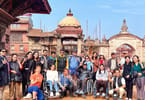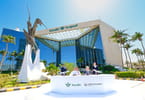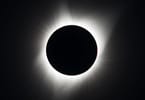The city of Najaf in Iraq is thriving as a religious tourist destination for Shia Muslims, with thousands of Iranians making a weekly pilgrimage to the sacred Imam Ali shrine. Could it be challenging the Iranian city of Qom as the centre of Shia religious authority?
As we entered the courtyard of the shrine, the shouting and bustle of the street faded away, and we heard the sound of singing, and the dull rhythmic thudding of fists beating chests.
Hundreds of men knelt on the carpeted floor repeating the word “Ali, Ali, Ali,” over and over, following the lead of a bearded chorus master, who stood before them, waving his arms, conducting the chant.
Other pilgrims wandered around, chatting quietly to one another, or engaged in silent prayer. But it wasn’t just their performance that set these men apart.
The chant itself sounded different, less harsh, and less guttural than the language on the streets; they were singing not in Arabic, but in Persian – softer, and more melodic.
The chanters were Iranians, some of the thousands of pilgrims, from cities like Tehran, Isfahan and Qom, who travel to Najaf every week, to the burial place of the Imam Ali.
Ali ibn Abi Talib was killed here in the 7th Century, struck from behind with a sword, as he led his followers in prayer.
His murder formed part of the battle for control of Islam that followed the death of the Prophet Mohammed, and which still reverberates to this day.
To Shia Muslims, Ali is the first Imam, the inheritor of the Caliphate, and the fact of his burial here made Najaf for many years the cultural centre of the Shia faith.
But starting in the late 1970s, two events conspired to send the city into decline.
The first was the rise to power of Saddam Hussein. As a member of Iraq’s Sunni minority, Saddam feared the power of the Shia, and set about ruthlessly dismantling their religious and cultural icons.
The other was the Islamic revolution in Iraq’s neighbour to the east.
Change in the air
In 1979, Iran became a theocracy, and Najaf gave way to the city of Qom as the centre of Shia religious authority.
But, today, in Najaf, there is a strong sense of change in the air.
Earlier on that same morning, we visited a nondescript house on a quiet backstreet of the city. Only the guards armed with Kalashnikov rifles gave any hint of the importance of the man who lived there.
This was the home of Sheikh Mohammed al-Yaqubi, one of five ayatollahs at the shrine.
“The city has never lost its significance,” he said, sitting in his book-lined study, his hands folded calmly in his lap, his white turban and white beard offset by a long brown robe.
“Other cities may compete with Najaf,” he said, “its role may have been minimised, but Najaf’s importance has never been diminished.”
Ayatollah Yaqubi seems quietly confident that Najaf is now regaining its status as the gravitational centre of the Shia faith.
There is more to this tug of war than a battle for influence between ayatollahs.
To ask the question, “Najaf or Qom?”, is to make a choice between two fundamentally different world views.
The clerics of Iran, with their power base in Qom, preside over a direct line of influence that runs from religion into politics.
Ayatollah Yaqubi, on the other hand, says that the religious authority at Najaf, does all it can to steer clear of politics, what he calls the “struggle for power”.
In an atmosphere of increasing sectarian tension ahead of the election in March, he and his fellow ayatollahs have resisted considerable pressure to publicly endorse Shia political parties.
‘Magnetic pull’
Najaf’s magnetic pull is strong. Released from the constraints imposed on it under Saddam Hussein, the city is thriving.
The millions of pilgrims who visit the city every year are bringing in money and creating jobs.
Travel agents specialising in religious tourism say business has never been better.
Some of that money is being spent on expanding the shrine itself.
Behind the mosque complex, in the shadow of the golden dome, almost blinding in the bright sunlight, construction is under way. Diggers are hard at work, building Najaf’s capacity to take in yet more pilgrims.
As Friday prayers were called, thousands of people thronged into the inner sanctum of the shrine, to touch and kiss the tomb of the Imam Ali.
These were pilgrims from across the world, their robes and headdresses as colourful and varied as the intricately patterned tiles on the walls of the mosque itself.
From this vantage point, Najaf appears to be on an irresistible trajectory upwards, both in terms of its economy, and as a cultural and religious centre.
But the view from Tehran may look a little different. As the growth of Najaf challenges the religious authority of Qom, so it undermines the power and authority of the Iranian state, as the spiritual and political leader of the world’s Shia Muslims.
WHAT TO TAKE AWAY FROM THIS ARTICLE:
- As we entered the courtyard of the shrine, the shouting and bustle of the street faded away, and we heard the sound of singing, and the dull rhythmic thudding of fists beating chests.
- To Shia Muslims, Ali is the first Imam, the inheritor of the Caliphate, and the fact of his burial here made Najaf for many years the cultural centre of the Shia faith.
- The chanters were Iranians, some of the thousands of pilgrims, from cities like Tehran, Isfahan and Qom, who travel to Najaf every week, to the burial place of the Imam Ali.






















